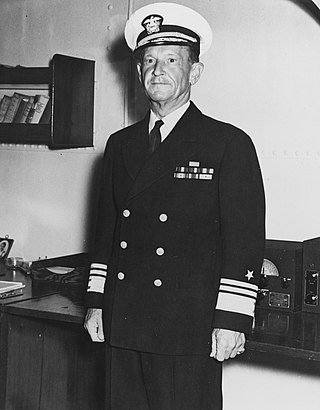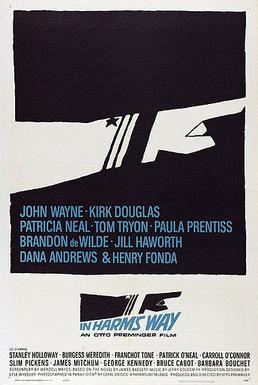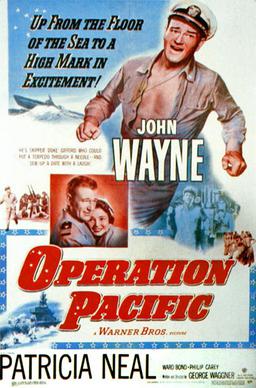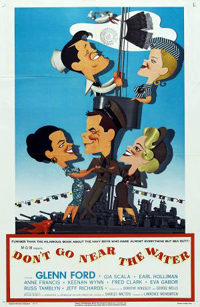
The Battle of the Coral Sea, from 4 to 8 May 1942, was a major naval battle between the Imperial Japanese Navy (IJN) and naval and air forces of the United States and Australia. Taking place in the Pacific Theatre of World War II, the battle was the first naval action in which the opposing fleets neither sighted nor fired upon one another, attacking over the horizon from aircraft carriers instead. It was also the first military battle between two aircraft carriers.

The submarine film is a subgenre of war film in which most of the plot revolves around a submarine below the ocean's surface. Films of this subgenre typically focus on a small but determined crew of submariners battling against enemy submarines or submarine-hunter ships, or against other problems ranging from disputes amongst the crew, threats of mutiny, life-threatening mechanical breakdowns, or the daily difficulties of living on a submarine.

Frank Jack Fletcher was an admiral in the United States Navy during World War II. Fletcher commanded five different task forces through the war; he was the operational task force commander at the pivotal battles of the Coral Sea and Midway, which collectively resulted in the sinking of five Japanese aircraft carriers.

Operation Petticoat is a 1959 American World War II submarine comedy film in Eastmancolor from Universal-International, produced by Robert Arthur, directed by Blake Edwards, and starring Cary Grant and Tony Curtis.

In Harm's Way is a 1965 American epic historical romantic war film produced and directed by Otto Preminger and starring John Wayne, Kirk Douglas, and Patricia Neal, with a supporting cast featuring Henry Fonda in a lengthy cameo, Tom Tryon, Paula Prentiss, Stanley Holloway, Burgess Meredith, Brandon deWilde, Jill Haworth, Dana Andrews, and Franchot Tone. Produced with Panavision motion picture equipment, it was one of the last black-and-white World War II epics, and Wayne's last black-and-white film. The screenplay was written by Wendell Mayes, based on the 1962 novel Harm's Way, by James Bassett.

Destination Tokyo is a 1943 black and white American submarine war film. The film was directed by Delmer Daves in his directorial debut, and the screenplay was written by Daves and Albert Maltz, based on an original story by former submariner Steve Fisher. The film stars Cary Grant and John Garfield and features Dane Clark, Robert Hutton, and Warner Anderson, along with John Ridgely, Alan Hale Sr. and William Prince.

Midway, released in the United Kingdom as Battle of Midway, is a 1976 American war film that chronicles the Battle of Midway, a turning point in the Pacific Theater of Operations of World War II. Directed by Jack Smight and produced by Walter Mirisch from a screenplay by Donald S. Sanford, the film starred Charlton Heston and Henry Fonda, supported by a large international cast of guest stars including James Coburn, Glenn Ford, Ed Nelson, Hal Holbrook, Robert Webber, Toshiro Mifune, Robert Mitchum, Cliff Robertson, Robert Wagner, Pat Morita, Dabney Coleman, Erik Estrada and Tom Selleck.

USS Blackfin (SS-322), a Balao-class submarine in commission from 1944 to 1948 and from 1951 to 1972, was a ship of the United States Navy named for the blackfin cisco, a food fish of the Great Lakes.

Operation Pacific is a 1951 black-and-white World War II submarine war drama from Warner Bros. Pictures, produced by Louis Edelman, and written as well as directed by George Waggner. John Wayne and Patricia Neal star and Ward Bond and Philip Carey play supporting roles.

Crimson Tide is a 1995 American submarine action thriller film directed by Tony Scott and produced by Don Simpson and Jerry Bruckheimer. It takes place during a period of political turmoil in Russia, in which ultranationalists threaten to launch nuclear missiles at the United States and Japan.

Patricia Cutts was an English film and television actress. She was the first person to portray the character of Blanche Hunt in ITV soap opera Coronation Street, appearing in two episodes.

Abraham Paul Wendkos was an American television and film director.

Takeo Takagi was an admiral in the Imperial Japanese Navy during World War II. He was the commander of the IJN 6th Fleet, which oversaw the deployment of all submarines.

Air Force is a 1943 American World War II aviation film directed by Howard Hawks and starring John Garfield, John Ridgely, Gig Young, Arthur Kennedy, and Harry Carey. The film was distributed by Warner Bros. and produced by Hal B. Wallis and Jack L. Warner. It contains incidents of supposed fifth-column activities by Japanese Americans that never happened. Conceived by then - Lieutenant General “Hap” Arnold in the aftermath of the Pearl Harbor attack, it was originally scheduled for release on December 7, 1942, on the first anniversary. It became impossible to meet that deadline, and it premiered in New York City on February 3, 1943 and was released on March 20. The film's storyline revolves around an actual event that occurred on December 7, 1941. An aircrew ferries an unarmed 1940 series Boeing B-17D Flying Fortress heavy bomber, named the Mary-Ann, across the Pacific to the United States Army Air Forces base at Hickam Field. They fly right into the middle of the Japanese air attack on Pearl Harbor and the beginning of America's major involvement in the Second World War. An uncredited William Faulkner wrote the emotional deathbed scene for Ridgely, who played the commander and pilot of the Mary-Ann.

Wing and a Prayer, The Story of Carrier X is a black-and-white 1944 war film about the heroic crew of an American aircraft carrier in the desperate early days of World War II in the Pacific theater, directed by Henry Hathaway and starring Don Ameche, Dana Andrews and William Eythe. It was nominated for the 1944 Academy Award for Best Original Screenplay.

The Atomic Submarine is a 1959 independently made, American black-and-white science-fiction film directed by Spencer Gordon Bennet and starring Arthur Franz, Dick Foran, Brett Halsey, Joi Lansing and Jean Moorhead, with John Hilliard as the voice of the alien. The film was produced by Alex Gordon and distributed by Allied Artists Pictures Corporation.

Don't Go Near the Water is a 1957 American comedy film about a U.S. Navy public relations unit stationed on an island in the Pacific Ocean during World War II. It is an adaptation of the 1956 novel of the same name by William Brinkley. Glenn Ford and Gia Scala star. This is the first of several service comedies that Ford appeared in after the huge success of The Teahouse of the August Moon. The movie was very successful and further solidified Ford's reputation as an adept comedic actor.

Destroyer is a 1943 American war film directed by William A. Seiter and starring Edward G. Robinson.

Hell Boats is a 1970 Technicolor British war film directed by Paul Wendkos that was filmed in Malta. It stars James Franciscus, Elizabeth Shepherd, and Ronald Allen in a story about British Motor Torpedo Boats in the Mediterranean in World War II. It was the last film made by Oakmont Productions, a branch of Mirisch Films. The film's technical advisor was Lieutenant Commander Ian Nagle Douglas Cox, who was awarded the Distinguished Service Order while serving in HMS Malcolm in 1940.

McHale's Navy is a 1964 American technicolor comedy film based on the 1962–1966 black and white television sitcom McHale's Navy starring Ernest Borgnine, Tim Conway and Joe Flynn, which had in turn originated with a one-hour anthology drama starring Borgnine entitled Seven Against the Sea. The film version was directed by series producer Edward Montagne and its supporting cast includes Carl Ballantine, Gavin MacLeod, Jean Willes, Claudine Longet, and George Kennedy. The film was followed by a sequel entitled McHale's Navy Joins the Air Force which did not feature Borgnine or Carl Ballantine. A remake entitled McHale's Navy, was released in 1997 and features an appearance by Ernest Borgnine playing a 75-year old McHale. The filming location for New Caledonia is the same as the one used in the series. For more information on the main characters see the TV series McHale's Navy. The movie was released on DVD for Region 1 on January 31, 2011.




















